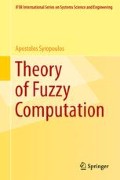Abstract
Turing machines form the core of computability theory, or recursion theory as it is also known. This chapter introduces basic notions and results and readers already familiar with them can safely skip it. The exposition is based on standard references [18, 39, 67, 83, 109]. In the discussion that follows, the symbol ℕ will stand for the set of positive integer numbers including zero and ℚ will stand for the set of rational numbers.
Access this chapter
Tax calculation will be finalised at checkout
Purchases are for personal use only
Notes
- 1.
Alternatively known as the free monoid with base A.
- 2.
In a nutshell, hypercomputation is the idea that there are conceptual and real computing machines that transcend the capabilities of the Turing machine. See [126] for an overview of the field of hypercomputation.
- 3.
A random set C in an ordinary set X is characterized by a function C: X → [0, 1], where C(x) denotes the probability that x ∈ X.
- 4.
Readers not familiar with these notions can consult Springer’s “Encyclopedia of Mathematics” web page.
- 5.
A connected component of any vertex is the maximal connected subcomplex that contains this vertex.
- 6.
A multidimensional Turing machine is one in which the tape can be either two or three dimensional. In the case of a two-dimensional machine, the transition function is of the form \(\delta: (Q \setminus H) \times \Gamma \rightarrow Q \times \Gamma \times \{ L,R,D,U,N\}\), where D and U specify movement of the scanning head up and down, respectively.
- 7.
Very roughly, a term yields a value; variables and constants are terms; functions are terms; atoms yield truth values; and each predicate is an atom. An atom is a formula. Given formulas p and q the following are also formulas: ¬p, \(p \vee q\), \(p \wedge q\), p ⇒ q, \(p \equiv q\), \(\forall xp\), and \(\exists xp\). In the last two cases x is said to be a bound variable, while in all other possible cases it is said to be a free variable.
- 8.
The graph of a function f: X → Y is the subset of X ×Y given by \({\bigl \{(x,f(x)) \vert x \in X\bigr \}}\). A total function whose graph is recursively enumerable is a recursive function.
- 9.
Actually, they call this “updated” version of the Church–Turing thesis the Church–Kalmár–Turing thesis, named after Church, László Kalmár, and Turing.
References
Boolos, G.S., Burgess, J.P., Jeffrey, R.C.: Computability and Logic, 4th edn. Cambridge University Press, Cambridge (2002)
Cook, S.A., Aanderaa, S.O.: On the minimum computation time of functions. Trans. Am. Math. Soc. 142, 291–314 (1969)
Copeland, B.J.: The Church-Turing thesis. In: Zalta, E.N. (ed.) The Stanford Encyclopedia of Philosophy, Fall 2002. http://plato.stanford.edu/archives/fall2002/entries/church-turing/
Cotogno, P.: Hypercomputation and the physical Church-Turing thesis. Brit. J. Philos. Sci. 54(2), 181–223 (2003)
Davis, M.: Computability and Unsolvability. Dover Publications, Inc., New York (1982)
Deutsch, D.: Quantum theory, the Church-Turing principle and the universal quantum computer. Proc. Roy. Soc. London A 400, 97–115 (1985)
Etesi, G., Németi, I.: Non-Turing computations via malament-hogarth space-times. Int. J. Theor. Phys. 41(2), 341–370 (2002)
Grigoriev, D.Y.: Kolmogoroff algorithms are stronger than Turing machines. J. Sov. Math. (now known as Journal of Mathematical Sciences) 14, 1445–1450 (1980)
Horowitz, E., Sahni, S.: Fundamentals of Data Structures in Pascal. Computer Science Press, Rockville (1984)
Hromkovič, J.: Theoretical Computer Science: Introduction to Automata, Computability, Complexity, Algorithmics, Randomization, Communication, and Cryptography. Springer, Berlin (2004)
Kleene, S.C.: General recursive functions of natural numbers. Math. Ann. 112, 727–742 (1936)
Kolmogorov, A.N.: On the notion of algorithm. Uspekhi Mat. Nauk 8, 175–176 (1953) (The paper is part of the Meetings of the Moscow Mathematical Society paper and the English translation used here is 77)
Kolmogorov, A.N., Uspensky, V.A.: On the definition of an algorithm. Uspekhi Mat. Nauk 13, 3–28 (1958) (English translation in 79)
Lewis, H.R., Papadimitriou, C.H.: Elements of the Theory of Computation, 2nd edn. Pearson Education, Harlow (1998)
Minsky, M.: Computation: Finite and Infinite Machines. Prentice-Hall, Englewood Cliffs, NJ, USA, 1967.
Ord, T., Kieu, T.D:. The diagonal method and hypercomputation. Brit. J. Philos. Sci. 56(1), 147–156 (2005)
Pontryagin, L.S.: Foundations of Combinatorial Topology. Graylock Press, Rochester (1952) (Translated from the first (1947) Russian edition by F. Bagemihl, H. Komm, and W. Seidel)
Rogers, Jr., H.: Theory of Recursive Functions and Effective Computability. The MIT Press, Cambridge (1987).
Santos, E.S.: Probabilistic Turing machines and computability. Proc. Am. Math. Soc. 22(3), 704–710 (1969)
Santos, E.S.: Computability by probabilistic Turing machines. Trans. Am. Math. Soc. 159, 165–184 (1971)
Syropoulos, A.: Hypercomputation: Computing Beyond the Church-Turing Barrier. Springer New York, Inc., Secaucus (2008)
Tremblay, J.-P., Sorenson, P.G.: The Theory and Practice of Compiler Writing, p. 16. McGraw-Hill, Singapore (1985)
Turing, A.M.: On Computable Numbers, with an application to the Entscheidungsproblem. Proc. London Math. Soc. 42, 230–265 (1936)
Author information
Authors and Affiliations
Rights and permissions
Copyright information
© 2014 Springer Science+Business Media New York
About this chapter
Cite this chapter
Syropoulos, A. (2014). A Précis of Classical Computability Theory. In: Theory of Fuzzy Computation. IFSR International Series on Systems Science and Engineering, vol 31. Springer, New York, NY. https://doi.org/10.1007/978-1-4614-8379-3_2
Download citation
DOI: https://doi.org/10.1007/978-1-4614-8379-3_2
Published:
Publisher Name: Springer, New York, NY
Print ISBN: 978-1-4614-8378-6
Online ISBN: 978-1-4614-8379-3
eBook Packages: Mathematics and StatisticsMathematics and Statistics (R0)

